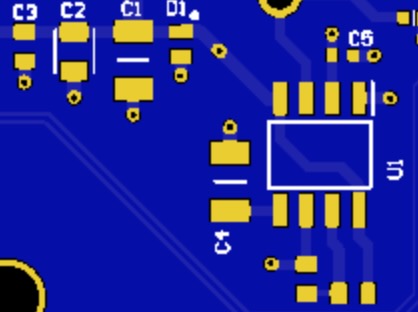Exact Measurement? For Innovation, and Progress
A coherence-based Noise Reduction System, approaches a time-independent reference, or exact standard, for the measurement of time. Download summary of scientific research here.
Observing An Increase In The Stability
Of Signal Voltage And Frequency
With Coherence Technology

Areas of Application of Coherence Technology Pdf download here: https://www.upgradingtechnology.com/support-files/areasofapplication.pdf
Increased Signal Stability
Transmit the signal to the oscilloscope and observe its stability. It will have a fixed voltage if it is stable. A stable voltage is easy to measure. An unstable one has to be averaged over a period.
Question: When you increase the stability to the point where the voltage is relatively constant, how would that specifically affect the audio signal?
Answer: The audio signal becomes stable. There is no drop in signal voltage. The frequencies more stable.
"There is no drop in signal,” means there is no sudden fall or rise in the voltage of the signal.
The strength of a stable signal remains fairly the same, making its dynamic range to be completely contained within the range of hearing, if it is an audio signal. In digital systems, a stable signal results in few errors and in power systems, it increases the life span of electrical appliances.
An unstable signal results in equipment damage, errors in digital systems, and in audio systems results in the possibility of hearing damage.
A listener hears a fairly uniform sound when the voltage is stable. For an unstable signal, a listener hears a sudden rise or fall in sound.
Signals appeared to be more stable with Coherence Technology.
Survey For Audio Signal Preference
In a survey of a cross section of consumers, two identical audio recordings were played. One had been processed with CT.
The result: 86% preferred the processed recording. Several follow-up “blind” and “double blind” tests resulted in a wide majority preferring recordings with Coherence Technology.
“Not only are the sounds clearer on my cassette tapes produced from this master, but the tone quality of the music is noticeably more true to the original sounds.” --Musician, Producer
Absolute sound summary of test: After plugging in the unit: “… What it does to the sound of the stereo is subtle but amazing. There is just a sense of looking further into the music – a lowering of the fatigue level and a sense of (dare I use the word?) coherency and depth.”
Applications
Signal stability is a fundamental component of many scientific and technological systems, ensuring consistent performance and reliable outcomes across various applications. "Signal stability" refers to the degree to which a signal maintains its properties over time, resisting distortion, noise, and interference that could compromise its integrity and the accuracy of information transmitted. When exploring advancements like Coherence Technology and its implications on signal stability, we can consider a wide range of potential benefits across multiple fields.
### Potential Applications and Benefits of Increased Signal Stability with Coherence Technology
1. **Telecommunications:**
- **Enhanced Data Transmission:** More stable signals can reduce the error rate in data transmission, improving the quality of voice, video, and data streaming services.
- **Network Reliability:** Improving signal stability enhances network reliability, essential for critical communications such as those for emergency services or financial transactions.
2. **Healthcare:**
- **Medical Imaging:** Stable signals are crucial in medical imaging technologies like MRI or ultrasound, where clearer and more reliable images can lead to more accurate diagnoses.
- **Patient Monitoring Systems:** Signal stability can improve the reliability of remote monitoring systems used for patients with chronic illnesses, ensuring consistent and precise readings.
3. **Aerospace and Navigation:**
- **GPS Accuracy:** Improved signal stability can lead to more precise positioning and navigation, essential for both civilian and military applications.
- **Space Communications:** Stable signals ensure better communication between spacecraft and ground stations, crucial for the success of space missions.
### Influence on Various Sectors
1. **Science and Technology:**
- Improved signal stability can lead to more reliable scientific experiments and research outcomes, promoting further advancements in technology and more robust findings in scientific research.
2. **Human Evolution and Sociology:**
- As Coherence Technology potentially enhances brain coherence, it can contribute to improved cognitive functions, reduced mental fatigue, and better decision-making. This can foster a more productive and mentally resilient society.
3. **Ecology:**
- Technological systems that operate with higher efficiency and less waste contribute to a smaller ecological footprint. Signal stability can help achieve this by optimizing the performance of systems in environmental monitoring and resource management.
4. **Creating a Problem-Free World:**
- Although it's ambitious to say any technology could create a world entirely free from problems, improving fundamental aspects like communication, healthcare accuracy, and ecological sustainability can address many contemporary challenges effectively. Enhanced brain coherence could also lead to a society that has better problem-solving abilities, more empathy, and a cooperative approach to global and local issues.
By improving the underlying stability and coherence of signals in various systems, we may witness enhancements not only in the functionality of devices and services but also in human cognitive capacities and societal structures. CT addresses ethical considerations effectively as a result of the increase in EEG brain coherence, which is associated with higher moral reasoning, and increased empathy. This is particularly relevant in terms of privacy, security, and the potential for unequal access to advanced technologies, as these could affect how beneficial outcomes are distributed among different groups within society.